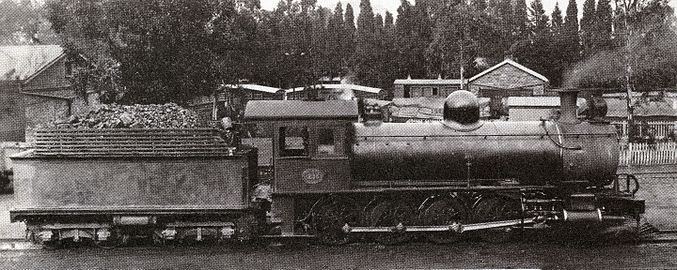South African Class 8F 4-8-0
| CGR 8th Class 4-8-0 1904 South African Classes 8F & 8FW 4-8-0 | |||||||||||||||||||||||||||||||||||||||||||||||||||||||||||||||||||||||||||||||||||||||||||||||||||||||||||||||||||
|---|---|---|---|---|---|---|---|---|---|---|---|---|---|---|---|---|---|---|---|---|---|---|---|---|---|---|---|---|---|---|---|---|---|---|---|---|---|---|---|---|---|---|---|---|---|---|---|---|---|---|---|---|---|---|---|---|---|---|---|---|---|---|---|---|---|---|---|---|---|---|---|---|---|---|---|---|---|---|---|---|---|---|---|---|---|---|---|---|---|---|---|---|---|---|---|---|---|---|---|---|---|---|---|---|---|---|---|---|---|---|---|---|---|---|---|
 Class 8FW no. 1236 plinthed at De Aar, 27 May 2013 | |||||||||||||||||||||||||||||||||||||||||||||||||||||||||||||||||||||||||||||||||||||||||||||||||||||||||||||||||||
| |||||||||||||||||||||||||||||||||||||||||||||||||||||||||||||||||||||||||||||||||||||||||||||||||||||||||||||||||||
| |||||||||||||||||||||||||||||||||||||||||||||||||||||||||||||||||||||||||||||||||||||||||||||||||||||||||||||||||||
| |||||||||||||||||||||||||||||||||||||||||||||||||||||||||||||||||||||||||||||||||||||||||||||||||||||||||||||||||||
| |||||||||||||||||||||||||||||||||||||||||||||||||||||||||||||||||||||||||||||||||||||||||||||||||||||||||||||||||||
| The leading coupled axle had flangeless wheels | |||||||||||||||||||||||||||||||||||||||||||||||||||||||||||||||||||||||||||||||||||||||||||||||||||||||||||||||||||
The South African Railways Class 8F 4-8-0 of 1904 was a steam locomotive from the pre-Union era in the Cape of Good Hope.
In 1904, the Cape Government Railways placed its final batch of ten 8th Class 4-8-0 Mastodon type steam locomotives in service. In 1912, when they were assimilated into the South African Railways, they were renumbered and designated Class 8F.[1][2][3]
Manufacture
Evolution

The first 8th Class locomotive of the Cape Government Railways (CGR) was a 2-8-0 Consolidation type designed by H.M. Beatty, the CGR’s Chief Locomotive Superintendent from 1896 to 1910. It was later to become the Class 8X on the South African Railways (SAR). While these first Schenectady- and ALCO-built 2-8-0 locomotives were being subjected to exhaustive testing on all types of traffic and under varying conditions, some trouble was experienced with the leading two-wheeled pony truck and, when designs were prepared at Salt River for a later order for more locomotives, it was replaced with a four-wheeled bogie.[1]
Builders
Orders for the last 8th Class locomotives for the CGR were placed with the North British Locomotive Company (NBL) in 1903. The ten locomotives were delivered in 1904, numbered in the range from 829 to 838 and allocated to the Western System of the CGR. They were delivered with Type XE1 tenders.[1][4]
These ten locomotives were the final batch of CGR 8th Class locomotives to be built with a 4-8-0 Mastodon type wheel arrangement. In spite of the differences in wheel arrangement, the CGR’s 8th Class 2-8-0 Consolidations and 8th Class 4-8-0 Mastodons were all grouped together into one single Class.[1][2]
Class 8 sub-classes
When the Union of South Africa was established on 31 May 1910, the three Colonial government railways (CGR, Natal Government Railways and Central South African Railways) were united under a single administration to control and administer the railways, ports and harbours of the Union. Although the South African Railways and Harbours came into existence in 1910, the actual classification and renumbering of all the rolling stock of the three constituent railways required careful planning and was only implemented with effect from 1 January 1912.[3][5]
In 1912, these ten locomotives were renumbered in the range from 1234 to 1243 and designated Class 8F.[6]
These locomotives, together with the rest of the CGR’s 8th Class 2-8-0 Consolidations and 4-8-0 Mastodons, plus the Classes 8-L1 to 8-L3 4-8-0 Mastodon locomotives from the Central South African Railways (CSAR), were grouped into ten different sub-classes by the SAR. The 4-8-0 locomotives became SAR Classes 8 and 8A to 8F and the 2-8-0 locomotives became Classes 8X to 8Z.[7]
Modification

During A.G. Watson’s term as Chief Mechanical Engineer of the SAR from 1929 to 1936, many of the Classes 8 to 8F locomotives were equipped with superheated boilers, larger bore cylinders and either inside or outside admission piston valves. The outside admission valve locomotives had their cylinder bore increased from 18+1⁄2 to 19 inches (470 to 483 millimetres) and retained their existing SAR classifications, while the inside admission valve locomotives had their cylinder bore increased to 20 inches (508 millimetres) and were reclassified by having a "W" suffix added to their existing SAR classifications.[2][7]
Of the Class 8F locomotives, numbers 1236, 1242 and 1243 were equipped with superheated boilers, 20 inches (508 millimetres) bore cylinders and inside admission piston valves, and reclassified to Class 8FW.[7]
Service
In SAR service, the 4-8-0 Class 8 family of locomotives worked on every system in the country and, in the 1920s, became the mainstay of motive power on many branchlines. Their final days were spent in shunting service. They were all withdrawn from service by 1972.[2]
Illustration
-
Ex CGR 8th Class no. 831, SAR Class 8F no. 1236, before modification and reclassification, c. 1930
References
- ^ a b c d Holland, D.F. (1971). Steam Locomotives of the South African Railways. Vol. 1: 1859–1910 (1st ed.). Newton Abbott, England: David & Charles. p. 67. ISBN 978-0-7153-5382-0.
- ^ a b c d Paxton, Leith; Bourne, David (1985). Locomotives of the South African Railways (1st ed.). Cape Town: Struik. pp. 48–49. ISBN 0869772112.
- ^ a b Classification of S.A.R. Engines with Renumbering Lists, issued by the Chief Mechanical Engineer’s Office, Pretoria, January 1912, pp. 9, 12, 15, 43 (Reprinted in April 1987 by SATS Museum, R.3125-6/9/11-1000)
- ^ North British Locomotive Company works list, compiled by Austrian locomotive historian Bernhard Schmeiser
- ^ The South African Railways - Historical Survey. Editor George Hart, Publisher Bill Hart, Sponsored by Dorbyl Ltd., Published c. 1978, p. 25.
- ^ Holland, D. F. (1972). Steam Locomotives of the South African Railways. Vol. 2: 1910-1955 (1st ed.). Newton Abbott, England: David & Charles. p. 140. ISBN 978-0-7153-5427-8.
- ^ a b c South African Railways and Harbours Locomotive Diagram Book, 2’0” & 3’6” Gauge Steam Locomotives, 15 August 1941, as amended

